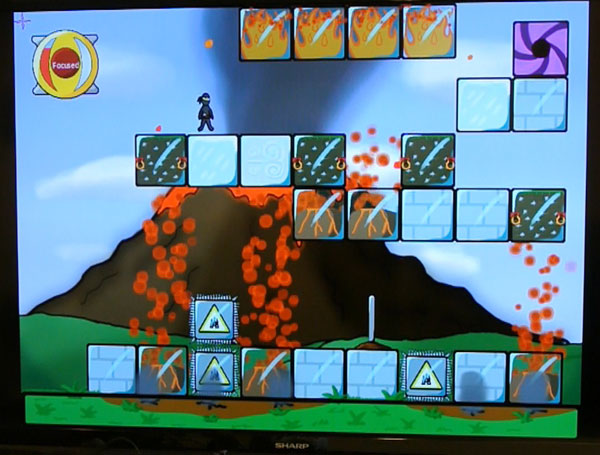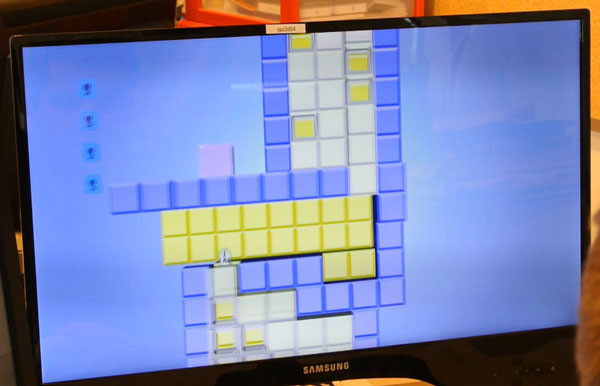3D, Virtual Reality, And Immersive Technology At The U Of OIT
Game Demonstrations Using Immersive Technologies
In addition to standard mouse/keyboard/gamepad-driven projects, the university encourages research into alternative input devices and game mechanics. You can see the influence of immersive technologies in the following demos:
Block Head is the result of a project showcasing how games might work with different input devices, and it uses an EEG monitor to report the player's mental state. In this side-scrolling platformer, the player controls a ninja directly, but the player's EEG result also changes the game world based on whether or not they are relaxed. The player needs to manage their brain state in order to make it through the levels: being calm can turn water into ice, while being agitated can turn some blocks into fire. The students created over 90 levels for this game.
This project explores a way to incorporate physical fitness into video game play. The player controls a first-person shooter while pedaling a stationary bike. The game reads pedaling speed and direction: pedaling forward assists offensive power, pedaling backwards improves defensive power, and higher pedaling speed earns better in-game abilities and rewards. Students built the original demo in a single day using a Half-Life 2 mod.
Magicduel is a two-player duelling game that employs Kinect sensors. Players use gestures to shoot balls of magic at one another, and they can move and jump to dodge their opponents' projectiles. This prototype game got some interest and was demoed on the Space Channel.
Students Tassos Stamadianos, Rohit Moni, and Brandon Drenikow were recruited to get a VR demo together for a tour. It took them just 24 hours to take Unity engine assets and create a first-person driving game that works on the Oculus Rift, complete with Razer Hydra hand controllers for steering. They later created another demo where the player controls a flying bird, also while wearing the Rift. You have to flap your arms (using Razer Hydra controllers) to move the bird's wings in VR, and fly through hoops.
This is a student's study project, designed to investigate whether or not apparent stereoscopic depth can be used as an action mechanic for gaming. The game is a top-down scroller where the player maneuvers a craft around hazards in 3D space, with the depth also marked by colors for 2D play. Despite the color indicators, players of the 2D version tended to give up, while players of the 3D version did quite well. For the next stage of the study, more indicators will be added so that 2D players have a better chance of successfully navigating the course.
Get Tom's Hardware's best news and in-depth reviews, straight to your inbox.
Current page: Game Demonstrations Using Immersive Technologies
Prev Page The Game Development And Entrepreneurship Program's Project Demonstrations Next Page Hardware: Cutting-Edge Immmersive Technologoies At UOITDon Woligroski was a former senior hardware editor for Tom's Hardware. He has covered a wide range of PC hardware topics, including CPUs, GPUs, system building, and emerging technologies.
-
xkm1948 Hopefully the development of neuroscience will help sending signals directly to one's cortex without being processed by vision system. It is already doable in auditory system, although it is still indirectly stimulus of cortex. With a better understanding of cortex mapping, we may finally be able to get signals directly into brain without all the sensory organs!Reply -
clonazepam baby steps... baby steps. I dont see how that's possible without destroying healthy brain tissue during the learning process, so it'll never happen. Maybe some lab rats might get to enjoy some corridor run-throughs from the latest ID software, Quake 37 or something, but that's about it.Reply
I like the idea of several companies coming together to build a market to share with each other. That'd be nice. I've got a 3D Vision ready monitor and glasses. I messed around with it some when I first got it, but the quality of the experience from one game to the next was anything but consistent. Longer play sessions were interrupted by having to recharge the glasses too.
I'm still hopeful that we get there someday. It's nice to know there's a group of people out there to decide where "there" is, and help define it as we move toward it. -
piklar Bunch o Chickmagnets.... things will get interesting when Occy R goes retail , cant help but think they will be hard pressed to keep up with demand "how could you NOT want one?" exciting times ahead..Reply
-
bystander ReplyHopefully the development of neuroscience will help sending signals directly to one's cortex without being processed by vision system. It is already doable in auditory system, although it is still indirectly stimulus of cortex. With a better understanding of cortex mapping, we may finally be able to get signals directly into brain without all the sensory organs!
While that may be interesting, and very useful for the blind, part of the experience we have with 3D is processing it in the same manner we do in real life. Through our eyes.
I am a big fan of 3D Vision myself. I really wish all the poor versions of 3D never existed, so people would stop calling it bad or a gimmick, because in the right games, it is truly awesome. 3D Vision has a great mod community that fixes a lot of games too, using the Helix mod, for those into 3D, it is a must to use their mods. -
bnot "Back in 2007, 3D was in the hands of hardcore fringe enthusiasts, and reliable information was very had to come by." ?Reply
http://en.wikipedia.org/wiki/Virtuality_(gaming)
Virtuality is a line of virtual reality gaming machines produced by Virtuality Group, and found in video arcades in the early 1990s. The machines deliver real time (less than 50ms lag) gaming via a stereoscopic visor, joysticks, and networked units for multi-player gaming.
Initially introduced in 1991, the systems were developed for industry, where the first two networked systems were sold to British Telecom Research Laboratories to experiment with networked telepresence applications. Many other systems were sold to corporations including Ford, IBM, Mitsubishi and Olin. Professional virtual reality systems included the launch of the Ford Galaxy in virtual reality and a virtual trading floor for the London International Financial Futures and Options Exchange (LIFFE). However, the users' thrill of talking and mutually interacting with each other as virtual characters refocused the company's direction.....
http://www.cybermind.nl/Our%20Products/VR%20LBE%20Systems/visette_01.gif
-
Shankovich Wat UOIT is doing this stuff? LOL wow I should go visit. When I was applying to university 4 years ago they were offering insane entering scholarships because they were so new, $8000 a year if you had an average above 90%. Glad to see they're doing so well!Reply -
Verrin I went to UOIT for nuclear science. It's a neato school, the high costs of tuition is because you're renting a laptop with expensive software suites on it (cost is more for the software than the hardware). I sort of cringed everytime the author said "U of OIT". No one calls it thaaaaaat. It's UOIT.Reply




